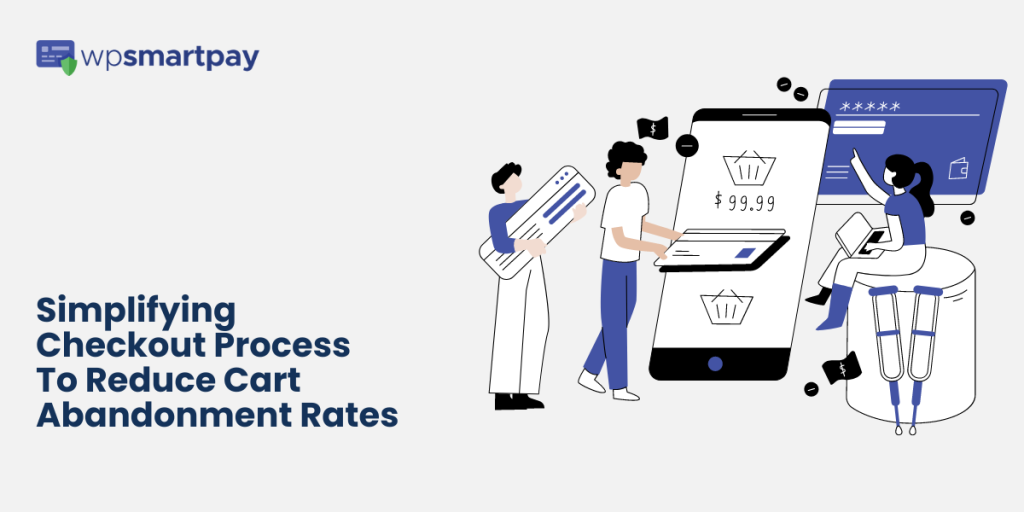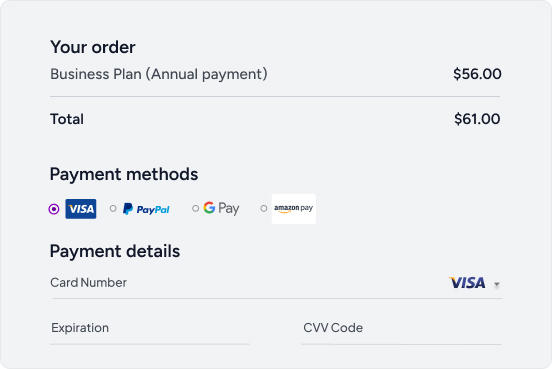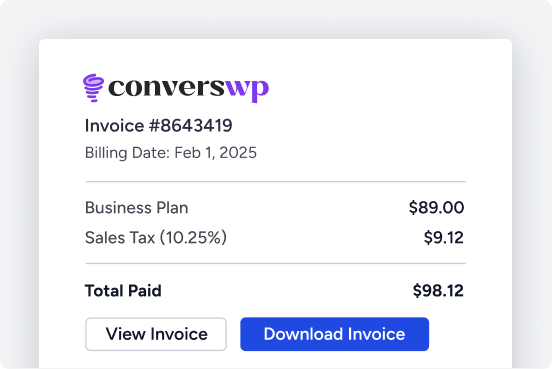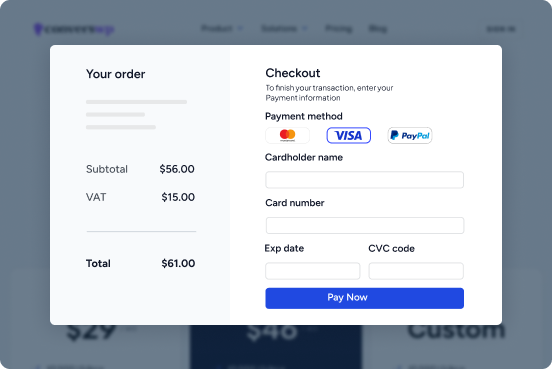Picture this: Your customer has just spent an hour browsing your store, carefully selecting the perfect items to add to their cart. They’re feeling good about their purchases and can’t wait to hit that “checkout” button.
But as soon as they’re directed to the payment page, their excitement turns to frustration. The process is long, confusing, and they’re bombarded with unnecessary questions. They’re not sure if their payment has gone through or if the order has been confirmed. In the end, they decide to abandon the cart altogether.
If your business is suffering from high cart abandonment rates, you’re not alone. In fact, according to a recent study, nearly 70% of online shopping carts are abandoned before checkout. That’s a staggering amount of potential revenue lost for businesses.
But fear not, because in this article, we’re going to show you how to simplify the checkout process and reduce cart abandonment rates for your customers.
You’ll also get to know about a handy tool called WPSmartPay that can help streamline the process for you.
So buckle up and get ready to take your online store to the next level!
Understanding Cart Abandonment Rates

What is cart abandonment rate?
First things first, let’s define what cart abandonment rates are. Simply put, it’s the percentage of customers who add items to their cart but then leave without completing the purchase. And let me tell you, those percentages can be brutal. We’re talking about 60-80% of customers abandoning their carts. Ouch.
Common reasons for cart abandonment

So, why do people do this? What could possibly be more important than completing a purchase they were already interested in? Well, there are a few common reasons;such as:
Unexpected Shipping Costs:
One of the biggest reasons for cart abandonment is unexpected shipping costs. People expect to see shipping costs during the checkout process, but if the cost is hidden until the last minute, customers can feel like they’ve been tricked or deceived.
To avoid this, be upfront about shipping costs from the beginning. You can offer free shipping, flat rate shipping, or calculate the shipping cost based on the customer’s location. Whatever you do, make sure it’s clear to the customer before they get to the checkout page.
Complicated Checkout Process:
Another common reason for cart abandonment is a complicated checkout process. If the checkout process takes too long, requires too much personal information, or has too many steps, customers are more likely to get frustrated and leave.
To simplify the checkout process, consider offering guest checkout, allowing customers to check out without creating an account. You can also reduce the number of steps by combining pages or eliminating unnecessary fields.
Anything you can do to make the process as smooth and easy as possible will help reduce cart abandonment rates.
Technical Issues:
Technical issues, such as a slow website or glitches during the checkout process, can also contribute to cart abandonment rates. Customers expect a smooth and easy experience when shopping online, so if they encounter issues, they’re more likely to give up and go somewhere else.
To avoid technical issues, make sure your website is optimized for speed and performance. Test the checkout process regularly to ensure it’s working properly and fix any glitches or bugs as soon as possible.
Impact of cart abandonment on business
Cart abandonment can have a significant impact on a business in several ways:
- Loss of revenue: When a customer abandons their cart, it means that the business loses out on a potential sale. This loss of revenue can add up quickly, especially if the business experiences high cart abandonment rates.
- Increased costs: Even if the customer doesn’t complete the purchase, the business may still have incurred costs such as advertising, marketing, and website maintenance. These costs can add up and impact the business’s bottom line.
- Decreased customer loyalty: A frustrating checkout process can leave a negative impression on the customer, making them less likely to return to the site in the future. This can lead to a decrease in customer loyalty and lower lifetime customer value.
- Negative impact on reputation: If customers regularly experience issues with the checkout process, it can damage the business’s reputation and make it less attractive to potential customers.
These impacts can not be overlooked, and that is why it’s essential for businesses to take steps to reduce cart abandonment rates and improve the checkout process.
Designing a Simple Checkout Process

Importance of a simple checkout process
If you want to take your online store to the next level, there’s one thing you can’t afford to overlook: a simple checkout process.
Not only does it reduce cart abandonment rates (one of the biggest problems facing ecommerce businesses today), but it also improves the overall user experience. And we all know that a happy customer is a loyal customer.
But that’s not all. A simple checkout process can also increase efficiency, making it easier for you to manage orders, process payments, and handle customer service inquiries.
And let’s not forget about the competitive advantage it provides. In a crowded ecommerce market, businesses that offer a seamless and convenient checkout process are sure to stand out from the crowd and attract more customers.
So if you want to boost your sales, improve customer satisfaction, and stay ahead of the competition, it’s time to start simplifying your checkout process.
Steps to design a simple checkout process
Listen up, ecommerce store owners! If you want to reduce cart abandonment rates and increase sales, you need to design a checkout process that’s so simple, even your grandma could use it. But where do you start?
According to the experts, there are seven essential steps that every ecommerce checkout process should include.
First, provide a summary of the cart contents.
Then, ask for shipping and payment information>show a summary of the order>confirm the purchase>end follow-up communication with order details and tracking information.
Finally, provide customer support and ask for feedback.
But wait, there’s more! To really simplify your checkout process and keep customers happy, you should also offer guest checkout, make it easy to reset forgotten passwords, use progress indicators, and offer multiple currencies and payment gateways.
And here’s a pro-tip: Don’t make customers register before they can make a purchase. Offer account creation after the sale on the “Thank You” page instead.
By following these best practices and designing a checkout process that’s easy to use and meets customers’ needs, you can increase conversion rates and reduce cart abandonment rates.
Examples of simple checkout processes:
A real life example would best fit the scenario here. Introducing, WPSmartpay
What is WPSmartPay?
When it comes to simplifying the checkout process, there’s one tool that stands out from the crowd: WPSmartPay. This powerful payment solution is designed to make the checkout process as seamless and painless as possible, so you can reduce cart abandonment rates and increase sales.
But what exactly does WPSmartPay do?
Well, for starters, it offers a one-page checkout process that’s quick and easy to navigate.
Plus, it supports a wide range of payment gateways, including PayPal, Stripe, and Paddle, so customers can pay with their preferred method.
And let’s not forget about the checkout customization options. With WPSmartPay, you can customize your checkout page to match your branding and create a seamless user experience.
You can also offer discount codes and coupons, which can help incentivize customers to complete their purchase.
How WPSmartPay simplifies the checkout process
As the name suggests, WPSmartPay handles the checkout process smartly. Whenever you want to make a purchase, you can click on get it now button:
Then provide some basic information and select the payment method,
Once you have selected your desired payment method, you need to provide your credentials for that specific payment method,
Finally, when you click on continue, you should be getting a payment confirmation message that looks like the following:
Features of WPSmartPay that improve user experience
When it comes to improving the user experience and making your ecommerce site stand out, WPSmartPay is the clear choice. This powerful payment plugin offers a wide range of features that make it easy to manage products, accept payments, and more.
- One of the standout features of WPSmartPay is its simple and intuitive drag & drop interface. With this interface, users can easily create unlimited products and multiple variations, set sale prices, and manage customer information.
- And with customizable payment features, you can control the way customers experience transactions, making it easy to offer a seamless checkout experience that keeps them coming back for more.
- WPSmartPay also supports one-time and recurring payments, so you can offer your customers the flexibility they need to pay however they choose.
- And with its support for Stripe, PayPal, Paddle, and bKash, you can rest assured that your payments will be processed quickly and securely.
- Finally, let’s not forget about the processing fees. WPSmartPay offers some of the lowest processing fees in the industry, making it easy for business owners to maximize their profits and keep more of their hard-earned money.
With its simple drag & drop interface, customizable payment features, support for one-time and recurring payments, and low processing fees, WPSmartPay is the ultimate payment solution for any business trying to sell digital products online.
Best Practices for Simplifying the Checkout Process

Guidelines for simplifying checkout process
A complicated or confusing checkout process can lead to frustration and, ultimately, cart abandonment. That’s why it’s essential to simplify the checkout process as much as possible.
So, without further ado, here are some best practices for simplifying the checkout process:
- Keep it short and sweet: The fewer steps involved in the checkout process, the better. Stick to the essentials and only ask for necessary information.
- Make it easy to navigate: Ensure that the checkout process is intuitive and easy to understand. Use clear language and provide helpful prompts throughout.
- Streamline payment options: Provide a variety of payment options, but don’t overwhelm customers with too many choices.
Importance of testing and refining checkout process
Now, it’s not enough to simply implement these best practices and call it a day. Testing and refining the checkout process is essential to ensure that it’s working as intended.
You can use A/B testing to experiment with different versions of the checkout process and see which one performs the best.
Wrapping Up!
As an ecommerce site owner, you know better than anyone the importance of providing a seamless and stress-free checkout process for your customers. Cart abandonment can be a frustrating and costly problem, but it’s not one that’s impossible to overcome.
By implementing the best practices for simplifying the checkout process that we’ve covered in this article, you can start to see a significant reduction in your cart abandonment rates. Keep it short, sweet, and easy to navigate, and don’t be afraid to test and refine your process regularly to ensure it’s working as intended.
Remember, every improvement you make to your checkout process is an opportunity to provide a better experience for your customers and ultimately drive more sales for your business. So, go forth and optimize!









